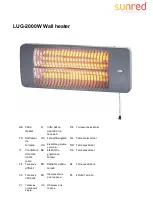
3
x
Set-up and installation
20
FA ROTEX SC+HYC - 10/2009
3.3.5
Filling the hot water heat exchanger
1.
Open shutoff device of cold water line.
2.
Open bleeding point for hot water so that as little bleeding as possible can be set.
3.
Once water has been discharged from the tap connections, do not interrupt the cold water feed; this will ensure that the
heat exchanger will be fully vented and that any impurities or residue will be discharged.
3.3.6
Filling the storage tank (without Solaris System installed)
1.
Connect the filler hose with back flow preventer (
½
") via the hose connector provided to the filling and drain connection
(Fig 3-8 - Fig 3-9, Item 11).
2.
Fill the storage tank of the ROTEX Sanicube / HybridCube until water comes out of the connection of the safety overflow
(Fig 3-8 / Fig 3-9).
3.3.7
Filling the storage tank (with Solaris System installed)
1.
Connect the filling hose with return flow inhibitor (
½
") to the boiler filling and draining valve on the Solaris control and pump
unit (RPS3).
2.
Fill storage tank of the ROTEX Sanicube / HybridCube until water flows out of the connection of the safety overflow
(Fig 3-8 / Fig 3-9).
3.3.8
Filling the heating system and the storage tank charging circuit
•
Fill and bleed the heating system and tank charge circuit in accordance with the installation and operating instructions for
the particular heat generator.
3.3.9
Connecting the electric immersion heater element (accessories)
EHS/500/1
The EHS/500/1 is delivered ready to plug in.
1.
Check the power supply voltage of the mains connection (
~230 V, 50 Hz
).
2.
Insert the mains plug of the electric immersion heater element into the plug socket.
EHS/500/5 and EHS/500/6
1.
Check the power supply voltage of the mains connection (
~230/400 V, 50 Hz
).
2.
Disconnect the junction box of the domestic electrical installation.
3.
Install the electric cabling between the mains connection and the electric immersion heater element.
WARNING!
Touching live parts can result in an
electric shock
and lead to potentially fatal injuries and burns.
•
Before beginning work on live parts, disconnect them from the power supply (switch off fuse, main
switch) and secure against unintentional restart.
•
Electrical connection and work on electrical components must only be carried out by qualified electricians
in compliance with valid standards and guidelines as well as the specifications of the energy supply
company.
•
Equipment covers and service flaps must be replaced as soon as the work is completed.













































